Uptake of water by plants more specifically by plant root hair is called water absorption. It is a vital process in case of plants as uptaken water along with minerals are mandatory for the survival of the plant body. In case of lower plants, the whole body acts as water absorbing organ but in higher plants, specific portion of the root absorbs water.
- Plants mainly absorb capillary water from the soil.
- Main organ for absorbing water is root hair.
- The absorbed water crosses a variety of cells such as cortical cells, endodermis (passage cells), pericycle cells and xylem tubes to reach the leaves.
- Absorbed water has major function in cell rigidity, cell vitality, cell turgidity, transpiration and photosynthesis.
Good to know
There are three kinds of water that are found in the soil namely: gravitational water, hygroscopic water, and capillary water. Among these water types, only the capillary water is useful for the plant.
Understanding capillary water: After rain, most of the water is absorbed by the soil. Though major part of that water is drained out of the soil, a small portion gets trapped between the narrow spaces of soil particles. This entrapped water that follows the laws of capillary action is known as capillary water.
Pathway of water absorption
Water absorption in plants through root can occur in two pathways. The water can move through the cell wall as it is made of cellulose which is hydrophilic, or it can move through the cytoplasm of the cells. The former is called apoplastic pathway and the later is symplastic pathway.
- Symplastic (Sym means cytoplasm)
- Through plasmodesmata.
- No hindrance.
- Apoplastic (Apo means without)
- Through cell wall and intercellular space.
- Hindrance in the form of casperian strip is present in endodermis.
- Water passes from cell wall of one cell to the cell wall of another.
From apoplastic pathway, water may enter into symplastic root and thus water passing is regulated.

Mechanism of absorption of water
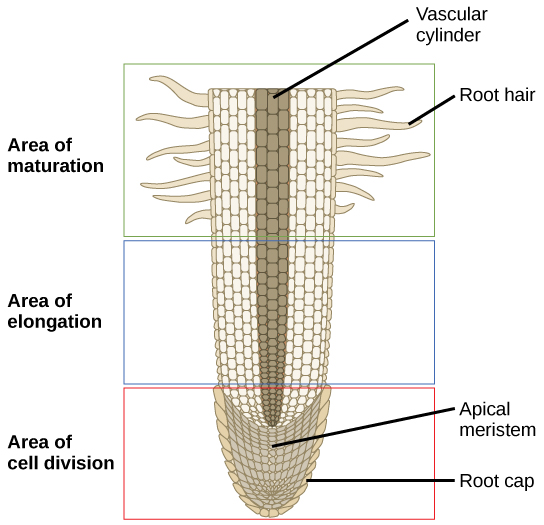
In higher plants, water is absorbed through root hairs which are in contact with soil water and form a root hair zone a little behind the root tips. Root hairs are tubular hair like prolongations of the cells of the epidermal layer of the roots.
- The walls of the root hairs are permeable to water and consists of pectic substances and cellulose which are strongly hydrophilic (water loving) in nature.
- Root hairs contain vacuoles with cell sap. So, they can create osmotic potential easily.
- When root hairs elongate, the older hairs die and new root hairs are developed so that they are in contact with fresh supplies of water in the soil.
Mechanism of water absorption in plants is of two types:
- Active absorption
- Passive absorption
Active absorption
In active absorption, the root hair cells play active role in water absorption by consuming metabolic energy (ATP) i.e. water is absorbed by roots’ own effort. So, this type of water absorption causes the increase in respiration rate.
- It takes place when transpiration is low and the quantity of water in the soil is high.
- The force for water absorption comes from the cells of root due to respiration.
- 4% of total absorption is carried out by the active absorption.
- Active absorption involves symplastic movement of water in root hairs.
- Evidences in support of active absorption are root pressure, bleeding and guttation (in hydathode).
- It is not the main method of water absorption.
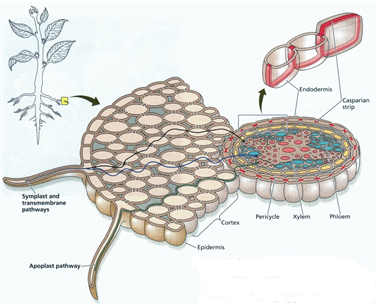
Good to know
Osmotic diffusion of water into endodermis takes place through special thin walled passage cells. Because the other endodermal cells have casperian strips in their walls which are impermious to water. Casperian strip is made up of suberin or wax which are hydrophobic.

Active absorption may be of two types:
1. Active osmotic absorption
In active osmotic absorption, water is absorbed from the soil into the xylem of the roots according to the concentration gradient. Here, the concentration of the cell sap inside the cell is greater than the concentration of solution in soil water. So, osmotic flow of water is observed.
2. Active non-osmotic absorption
Here, the concentration of cell sap is lower than the concentration of soil solution. So, water is absorbed through root hairs by spending energy against the concentration gradient.
- Abnormal condition.
- Require expenditure of metabolic energy (ATP) probably through respiration.
Following evidences support this view:
- The factors which inhibit respiration also decrease water absorption. (No respiration causes no ATP. Because of the lack of energy, water absorption decreases.)
- Poisons which retard metabolic activities of the root cells also retard water absorption.
- Auxins (growth hormones) which increases metabolic activities of the cells stimulate absorption of water.
Passive absorption
Passive absorption doesn’t require any metabolic energy. It occurs with the help of metabolic activity like transpiration. Here, due to transpiration, a pull or tension is created along the water column that extends from the leaf to the root. So, as water evaporates from the leaf stomata, the pull causes water entry inside the root xylem. Thus water is absorbed.
- Root hairs play passive role. Thus called absorption ’through roots’ rather than ‘by roots’.
- Occurs when rate of transpiration is usually high because of opening and closing of stomata.
- Driving force for water absorption is transpiration.
- In passive absorption, water moves probably through the free spaces or apoplast (cell wall + intercellular space) of root.
- Passive absorption occurs due to tension created in the xylem cells of the leaves by rapid transpiration or evaporation. This tension is transmitted to the xylem of roots through the xylem of stem and water rises upward to reach the transpiring surface. As a result, soil water enters into cortical cells through root hairs.
Evidence of passive absorption
Evidence in support of passive absorption can be given by cutting the roots under water. The absorption of water still continues if all the roots are removed. This proves that root isn’t mandatory here and water is absorbed because of the pool created through respiration.
External factors affecting absorption of water
1. Available soil water
Increase in soil water doesn’t necessarily mean increase in water absorption. Rather a limited increase in capillary water of soil may cause to increase water absorption rate.
2. Concentration of the soil solution
As shown in the active absorption, the process is quite dependent on concentration gradient. The concentration in soil thus plays a major role in determining whether energy is required or not and to what quantity.
3. Soil air (O2)
Absorption of water is retarded in poorly aerated soils because in such soils the deficiency of O2 and consequently the accumulation of CO2 will retard the metabolic activities of the roots like respiration. This also inhibits the active absorption of water.
4. Soil temperature
The optimum temperature is 20-35 degrees Celsius.
Difference between active and passive absorption
| Active absorption | Passive absorption |
| Energy is required. | Energy is not required. |
| Created by osmotic gradient. | By transpiration pull. |
| Absorption is due to activity of root hair cells. | Absorption is due to activity of stomata containing organs mostly leaves. |
| Absorption by root hairs. | Absorption through root hairs. |
| Absorption done through mostly symplastic pathway. | Done mostly through apoplastic pathway. |
| Correlated with respiration for ATP. | Correlated with transpiration. |
| Rate of absorption is slow. | Rate of absorption is fast. |
Food for thought
- In which method, dry wood can absorb water?
- Why does active absorption mostly involve symplastic movement of water?
- Why does passive absorption mostly involve apoplastic movement of water?
Useful Links
- Absorption of water in plants.
(will be glad if you drop some other useful links in the comment box)
Revised by
- Abulais Shomrat on July 29, 2020.
 Plantlet The Blogging Platform of Department of Botany, University of Dhaka
Plantlet The Blogging Platform of Department of Botany, University of Dhaka
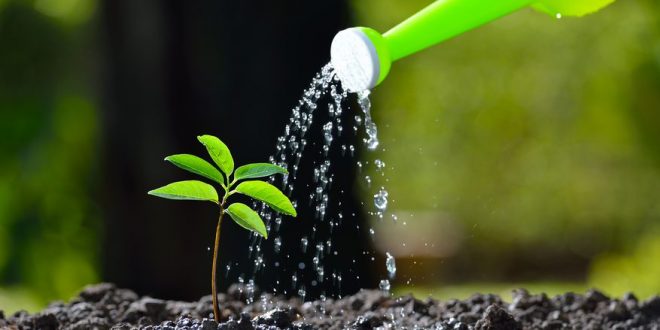

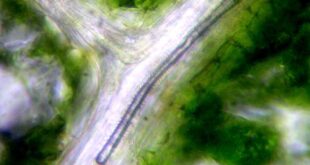
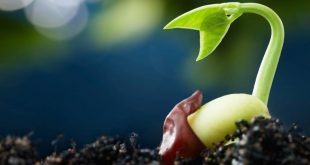
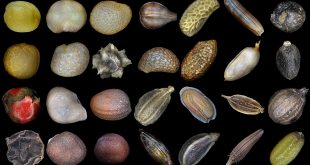

Would be much more benifitial with quick view of difference table/s.
Hope you like it now.
Would be glad if you can drop any new point or suggestion regarding this article.
its on next level. thanks for letting us know